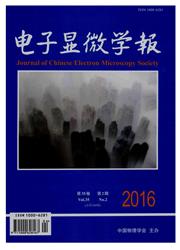

 中文摘要:
中文摘要:
本文利用高分辨透射电子显微技术及高分辨像几何相位分析技术,对分子束外延方法生长在GaSb(001)面上的InAs/GaSb11型超晶格材料进行了界面显微结构和解理特征的研究。众所周知,InAs和GaSb都是立方硫化锌结构,具有平行于{110}面的六组完全解理面,然而,本工作中发现InAs/GaSb超晶格的解理面发生改变,平行于{111}面解理,并在InAs/GaSb界面处发生扭折,呈现锯齿状解理边缘。而在InAs盖帽层即非超晶格区域内,解理面依然平行于{110}面。通过建立超晶胞模型与计算分析表明,在超晶胞中由于共格应力的对称性降低,(110)面的电中性发生改变,导致解理面从电中性的{110}面转变为面网密度最大的{111}面。界面两侧应力分布分析结果表明,锯齿状{111}解理边缘是Ga-As型界面与In-sb型界面所受应力作用不同的结果。
 英文摘要:
英文摘要:
Type-II InAs/GaSb superlattices (SLs) grown on (100) GaSb substrates by molecular beam epitaxy were investigated by using high-resolution transmission electron microscopy (HRTEM) and Geometric Phase Analysis (GPA). It is well known that both InAs and GaSb are the zinc-blende structure and their cleavage planes are { 110 } planes, which is used for the cleaved-edge overgrowth method. However, this work show that the cleavage planes in the InAs/GaSb SLs have been changed into t 111 I planes. The HRTEM observations revealed that a zigzag cleaved-edge across the InAs/GaSb SLs consisted of atomically flat { 111 } facets of InAs and GaSb and kinked at each InAs/GaSb intersection. Out of the SLs' area, the cleavage was back to { 110} plane in the InAs contact layers. Based on the selected area electron diffraction analysis and the strain mapping across each interface, the zigzag {111} cleaved-edge was attributed to the strain-induced symmetry reduction and the strain difference between Ga-As and In-Sb interfaces.
 同期刊论文项目
同期刊论文项目
 同项目期刊论文
同项目期刊论文
 期刊信息
期刊信息
